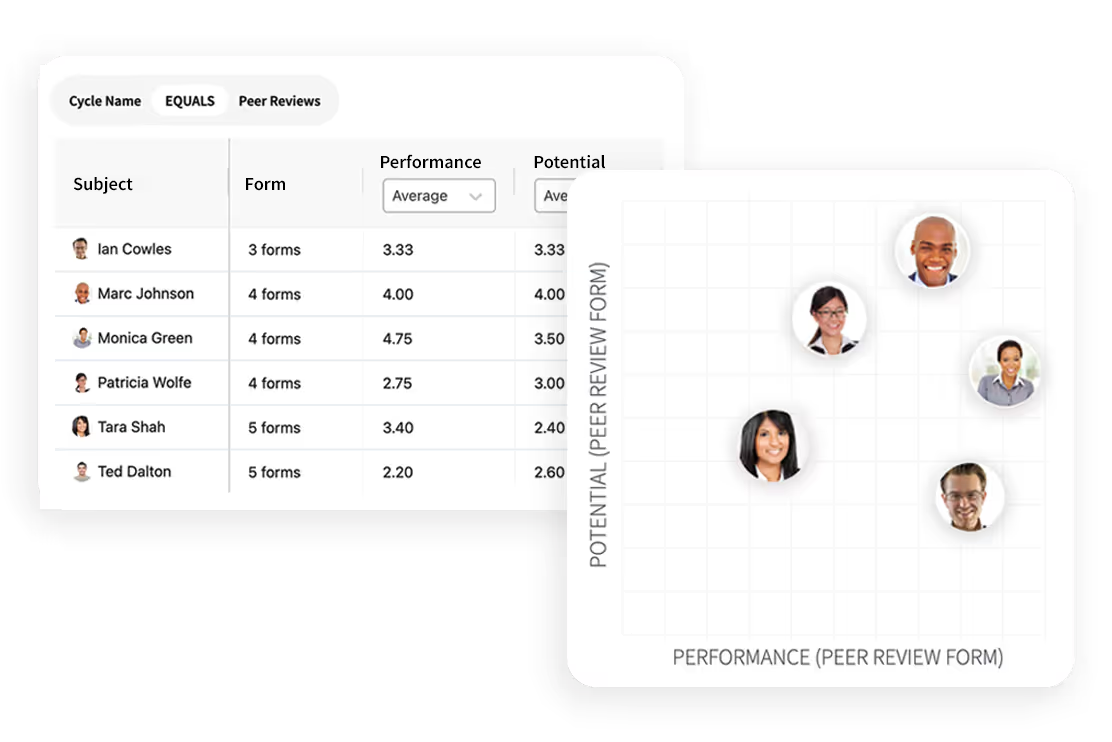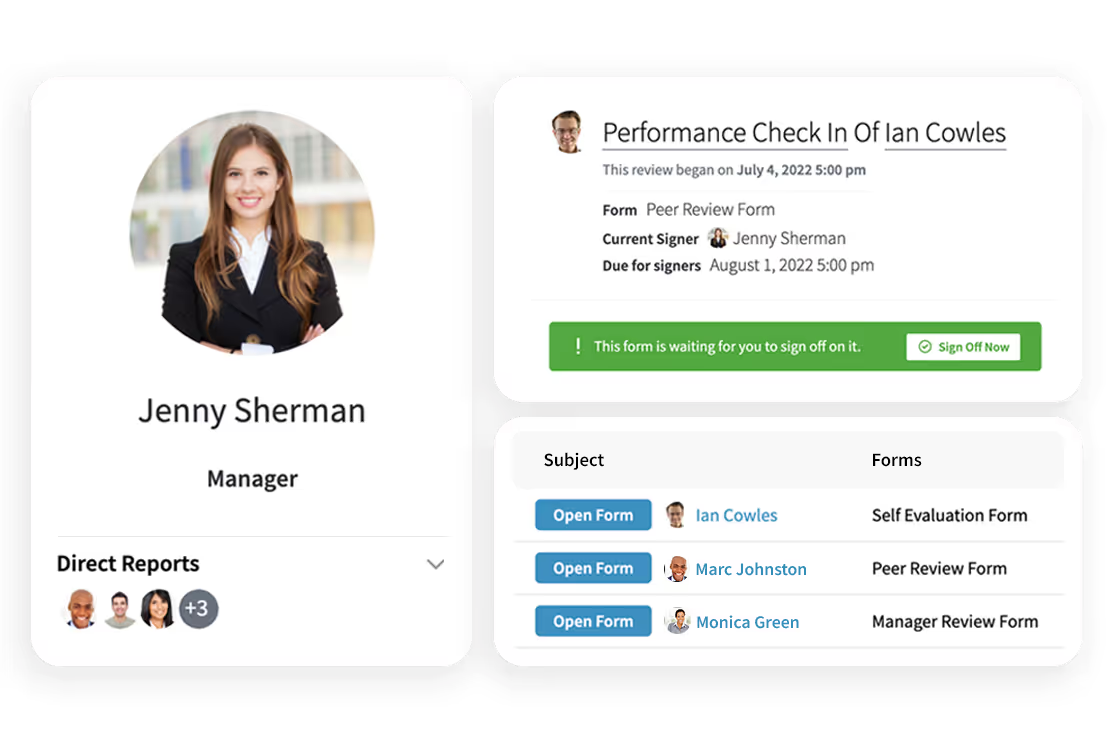Law Enforcement Performance Management & Evaluation Examples
Evaluating law enforcement performance is no easy task. You can’t reduce an officer’s work to just numbers on a spreadsheet.
Arrest counts, response times, and case closures tell part of the story, but what about the officer who defuses a volatile domestic situation without an arrest? Or the one who spends extra time building trust in their community?
These are the moments that define modern policing, but they’re harder to measure.
This article takes a fresh look at police performance evaluations. It’s about moving beyond the basics to explore strategies that capture the real value officers bring to their departments and communities. We’ll cover frameworks, metrics, and challenges, weaving in real-world examples to bring it all to life.
What Makes Police Evaluations So Different?
Police work doesn’t fit neatly into traditional evaluation models. For most professions, it’s straightforward to measure success: Did you meet your sales quota? Finish the project on time?
But law enforcement operates in gray areas. Officers are expected to enforce laws, build trust, de-escalate conflicts, and, increasingly, serve as the first line of response for mental health crises.
Take Officer Martinez from a rural New Mexico department. Her community rarely sees violent crime, so her “numbers” on paper might look unimpressive. But residents consistently praise her for resolving disputes between neighbors, helping seniors navigate social services, and calming family tensions before they spiral. Without evaluations that account for these contributions, officers like her could easily go unrecognized.
Competency-Based Evaluations: Focusing on the Right Skills
The days of measuring performance by arrest quotas or ticket counts are (mostly) behind us. Instead, many departments are pivoting to competency-based evaluations. These frameworks focus on essential skills—like communication, decision-making, and emotional intelligence—that make officers effective in the field.

As a real-world example, consider how the Dallas Police Department assesses officers. They apply de-escalation techniques during high-stress encounters. Supervisors review body camera footage and pair it with field observations to rate officers on criteria such as “ability to defuse volatile situations” and “judgment under pressure.”
Incorporating Community Feedback
Community input is critical for police evaluations in today’s landscape. After all, officers serve the public. Yet, many departments still overlook this perspective.
Camden, NJ, faced widespread mistrust after years of aggressive, quota-driven policing. In response, the department revamped its approach, integrating community satisfaction into officer evaluations. Residents now participate in surveys and town halls to share feedback on officer performance.
One Camden officer described the change: “It’s no longer about how many tickets you write—it’s about how you leave people feeling.” According to the department, violent crime dropped by 50% in five years, and trust between the police and the community significantly improved.
Metrics That Go Beyond the Numbers
Traditional metrics like arrest rates or response times can’t capture the complexities of modern policing. They’re important, but they don’t tell the whole story.
Emerging Metrics Include:
- Community Sentiment: Departments like the Seattle Police Department gather feedback through surveys and focus groups. While this data can be subjective, it gives a clearer picture of how officers are perceived in the neighborhoods they serve (source).
- Use-of-Force Trends: A department’s ability to reduce use-of-force incidents often reflects the success of de-escalation training.
- Problem-Solving Outcomes: Metrics that track how officers address recurring community issues, like nuisance properties or chronic disputes, offer a more holistic view of their impact.
Frameworks for Comprehensive Performance Management
Annual evaluations feel outdated. Supervisors can’t remember details from months ago, and officers get blindsided by feedback that no longer feels relevant.
Departments like the Denver Police Department are addressing this with bi-weekly check-ins. Officers meet with supervisors to discuss performance, receive coaching, and address challenges as they arise.

One Denver sergeant noted, “These sessions save me time in the long run. I’d rather tackle small issues early than clean up a mess later.”
Practical scenarios are another way to assess performance. The San Francisco Police Department uses simulated drills, like active shooter situations or mental health crises, to evaluate officer decision-making under pressure. These exercises provide a clear lens into how officers might perform when it matters most.
Performance Evaluations by Role
Law enforcement roles tend to have tailored performance evaluation criteria, though core competencies (communication, judgment, integrity) are common across positions. Evaluations typically use rating scales and narrative feedback covering job-specific duties and departmental values. Below we present example criteria on a role-by-role basis.
Patrol Officer (Front-Line Uniformed Officer)
Knowledge & Application of Law/Policy: Understanding criminal laws, department policies, and proper procedures. Officers must correctly apply legal standards and follow protocols for arrests and evidence handling.
Quality of Work: Accuracy and thoroughness in reports and investigations. Report narratives should be clear, complete, and require minimal corrections.
Productivity & Initiative: Work output and proactive engagement. Includes handling calls, initiating traffic stops, and staying self-motivated. Many departments focus on meaningful activity rather than quotas. Example: "Officer Jones took initiative conducting extra patrols in a burglary-prone area, leading to reduced incidents."
Officer Safety & Use of Force: Adherence to safety protocols and appropriate force use. Evaluations review body-camera footage to assess de-escalation abilities and judgment under pressure.
Communication & Public Interaction: How officers communicate with public, victims, and colleagues. Includes radio communication, writing skills, and interpersonal tact. Departments value public contact skills—honesty, courtesy, and ability to calm people in crisis.
Dependability and Work Habits: Reliability in attendance, punctuality, and following instructions. Includes proper equipment care and adherence to safety regulations.
Key competencies include decision-making, problem-solving, ethical integrity, teamwork, and community policing knowledge.
Detective (Investigative Officer)
Case Clearance & Investigative Effectiveness: Success in solving cases and investigation quality. Supervisors assess how thoroughly detectives pursue leads, process crime scenes, and collaborate with prosecutors. Attention to detail in case files and evidence logs is critical.
Judgment and Decision-Making: Sound decisions during investigations, including prioritizing leads and determining when to seek warrants. Detectives operate with relative autonomy, requiring objectivity in complex cases.
Job Knowledge: Knowledge of investigative techniques, forensic procedures, and relevant laws. Must stay current on interview techniques, evidence handling, and evolving legal standards.
Interpersonal Skills: Ability to interview witnesses and victims effectively, working as a team with patrol officers, forensic units, and attorneys. Building rapport and credibility is essential for cooperative witnesses and prosecutor relationships.
Written Communication: Quality of investigative reports, affidavits, and case documentation. Clear, detailed writing is essential for court proceedings and case solvability.
Workload Management: Managing multiple cases and meeting deadlines through organizational skills, proper case file maintenance, and timely case closure.
Key competencies include judgment/decision-making, attention to detail, objectivity, fact-finding, interpersonal skills, teamwork, and credibility.
Police Supervisor (Sergeant, Lieutenant)
Leadership & Supervisory Ability: Guiding and developing subordinates through positive example, maintaining discipline, delegating tasks, and providing coaching. Effective supervisors schedule tasks, train officers, solve problems, and make fair decisions.
Management Skills: Managing unit operations, developing policies, organizing work efficiently, and meeting organizational goals. Includes administrative duties like approving reports and scheduling shifts.
Communication: Clear communication up and down the chain of command, including briefing officers, writing evaluations, and conveying directives. Strong interpersonal skills maintain team morale.
Knowledge and Decision-Making: Well-versed in department policies, legal standards, and best practices. Judgment scrutinized in use-of-force reviews and citizen complaint handling.
Community and Employee Relations: Engagement with community concerns and maintaining employee satisfaction. Fostering positive, professional work environments and addressing community needs.
Key competencies revolve around leadership, accountability, and strategic thinking. Supervisors must balance operational knowledge with people management skills, often with goals tied to team performance metrics and development outcomes.
Police Department Performance Measures (Organizational KPIs)
Police departments in the U.S. track key performance indicators (KPIs) to gauge agency effectiveness and community impact. These metrics cover crime reduction, responsiveness, community trust, accountability, and internal development. Since no single measure captures success, departments use multiple indicators. Here are some examples to consider.
Response Time
How quickly officers respond to calls for service, measured as average time from 911 call to officer arrival. Agencies set targets (e.g., respond to emergencies within X minutes) and track performance against benchmarks. Scottsdale, AZ publicly tracks average response time to top-priority calls quarterly.
Crime Rate
Number of reported crimes per jurisdiction, normalized per 1,000 or 100,000 population and broken down by category (violent, property crime) and time period. While core indicators, crime rates are influenced by external factors, so they're paired with other metrics for context.
Crime Clearance Rate
Percentage of crimes "cleared" (by arrest or exception) from those reported. This gauges investigative effectiveness. Departments track clearance for major crime types and compare to national averages. Tempe, AZ achieved ~39.2% violent crime clearance with a ~43.5% goal.
Calls for Service Volume
Total police service calls handled, broken down per capita or by type. This reflects demand and informs resource allocation. Sudden increases prompt analysis of incident patterns. Calls per officer indicate workload levels.
Community Satisfaction and Engagement
Departments use surveys to assess public trust and perceived safety. Common KPIs include percentage of residents feeling safe in neighborhoods. Agencies track community outreach events and participation levels. Camden, NJ integrated community feedback into evaluations, achieving improved sentiment and 50% violent crime reduction over five years.
Use of Force and Complaints
Modern performance management tracks force usage and officer behavior. KPIs include use-of-force incidents, outcomes, and citizen complaints with their dispositions. Rising complaints may flag conduct or community relations issues. The NYPD's Risk Management Bureau uses data from lawsuits and complaints to identify officers needing additional training or supervision.
Training and Professional Development
Departments measure training compliance and proficiency, including percentage of officers completing required annual training and total training hours provided. Well-trained officers perform better, making high completion rates indicators of departmental commitment to excellence.
Workforce and Safety Metrics
Include officer wellness measures like overtime hours (monitoring burnout), injuries, deaths in line of duty, and turnover rates. Departments may track workforce diversity as a performance measure, believing representative forces improve community relations.
Tackling Challenges in Police Evaluations
Bias can creep into any evaluation system. Structured tools, like Behaviorally Anchored Rating Scales (BARS), are one solution. These scales tie performance levels to observable behaviors, reducing the influence of personal opinions.
For example, a supervisor might rate an officer’s decision-making during a traffic stop based on criteria like “explains actions clearly to civilians” or “remains calm when faced with resistance.”
Here’s another challenge: balancing quantitative goals with the human side of policing. A rural sheriff’s department in Montana recently faced backlash for emphasizing arrest numbers. Officers, frustrated with the quota-like system, pushed for evaluations that recognized their outreach work instead. After including community engagement metrics, morale improved—and so did public relations.
Lessons from the Field
The Metropolitan Police Service (Scotland Yard) uses its “National Decision Model” to evaluate officers. This model emphasizes ethical decision-making and transparency. Officers are assessed on how well they apply the framework in real-world situations, helping create a culture of accountability.
The Oakland Police Department offers another example. They incorporate advisory committees into the evaluation process. These committees, composed of community members, review performance metrics and provide feedback on how well officers align with public expectations. This collaboration has improved relationships between officers and residents, fostering a more cooperative environment.
Takeaways for HR Professionals and Police Managers
- Tailor Evaluations to Your Context - No two departments are alike. Rural areas might prioritize resource management, while urban centers focus on community engagement. Build an evaluation framework that fits your unique needs.
- Make Evaluations Development-Oriented - Use evaluations as a springboard for growth. For example, tie poor performance reviews to specific training opportunities or mentorship programs, rather than punitive measures.
- Collaborate with External Stakeholders - Bring in academics, community leaders, or independent consultants to create evaluation criteria that are fair and aligned with public expectations.
Using PerformYard to Optimize Police Performance Evaluations
If you’re looking for a way to streamline everything discussed here, PerformYard could be your go-to solution. This performance management platform offers the tools to create customized evaluation frameworks tailored to your department’s needs.
Want to incorporate community feedback? PerformYard allows you to design feedback forms that can be distributed to residents, ensuring their voices are part of the evaluation process.
Need to track de-escalation incidents or officer training completion? Its flexible performance tracking features enable you to document metrics that go beyond the traditional numbers game.
What makes PerformYard especially effective for law enforcement is its adaptability. Whether you’re managing a small-town police department or a large urban force, you can set up workflows for continuous feedback, scenario-based evaluations, or even 360-degree reviews.
Supervisors can provide real-time coaching while maintaining detailed, secure records of an officer’s performance over time. This helps ensure evaluations are transparent, actionable, and aligned with both internal goals and community expectations.
In short, PerformYard gives departments the structure they need without sacrificing the human touch that makes evaluations meaningful.



.jpg)

